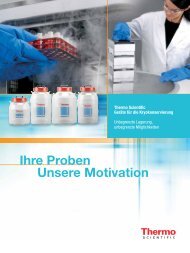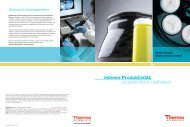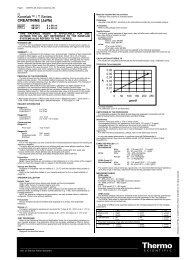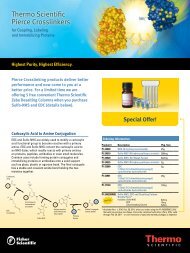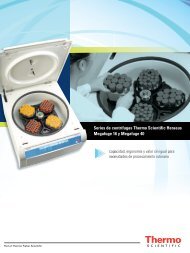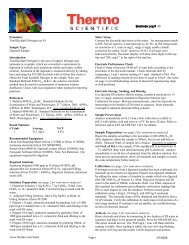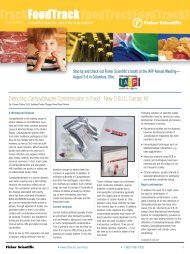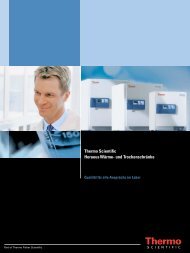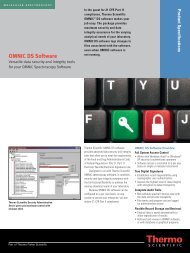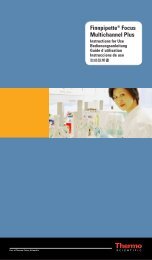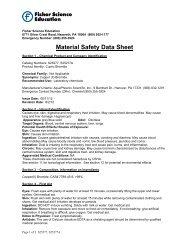DRI® Cocaine Metabolite Assay - Fisher Scientific
DRI® Cocaine Metabolite Assay - Fisher Scientific
DRI® Cocaine Metabolite Assay - Fisher Scientific
Create successful ePaper yourself
Turn your PDF publications into a flip-book with our unique Google optimized e-Paper software.
DRI ® <strong>Cocaine</strong> <strong>Metabolite</strong> <strong>Assay</strong><br />
For In Vitro Diagnostic Use Only<br />
10014593 (3 x 18 mL)<br />
0055 (100 mL Kit)<br />
0056 (500 mL Kit)<br />
Intended Use<br />
The DRI <strong>Cocaine</strong> <strong>Metabolite</strong> Enzyme Immunoassay is a homogeneous enzyme immunoassay<br />
intended for the qualitative and semi-quantitative determination of benzoylecgonine (<strong>Cocaine</strong><br />
<strong>Metabolite</strong>) in human urine with either 300 ng/mL or 150 ng/mL as a cutoff calibrator.<br />
The assay provides only a preliminary analytical test result. A more specific alternative<br />
chemical method must be used to obtain a confirmed analytical result. Gas chromatography /<br />
Mass spectrometry (GC/MS) is the preferred confirmatory method. 1,2 Clinical and professional<br />
judgment should be applied to any drug of abuse test result, particularly when preliminary<br />
results are used. Tests for cocaine metabolite cannot distinguish between abused drugs and<br />
certain prescribed medications.<br />
Summary and Explanation of the Test<br />
<strong>Cocaine</strong> (benzoylmethylecgonine), is derived from the plant species Erythroxylon coca, which<br />
is widely grown in South America. 3-5<br />
<strong>Cocaine</strong> is a very common illicit drug and is popularly abused in the US. 3,4,6 <strong>Cocaine</strong> abuse can<br />
produce euphoria, arousal, garrulousness, alertness, anxiety, insomnia, hyperactivity, paranoia,<br />
severe psychosis, and even suicide. 3,6,7<br />
<strong>Cocaine</strong> is rapidly metabolized, with less than 5% excreted unchanged in the urine. 4,6,7 The<br />
two major metabolites, which result from enzymatic and nonenzymatic hydrolysis, are<br />
benzoylecgonine and ecgonine methyl ester. 4,6-9 The metabolites may be detectable in urine for<br />
up to 3 weeks after long term, heavy use of cocaine. 10,11<br />
The DRI ® <strong>Cocaine</strong> <strong>Metabolite</strong> <strong>Assay</strong> is a homogeneous enzyme immunoassay using ready-touse<br />
liquid reagents. 12 The assay uses a specific antibody, which can detect benzoylecgonine in<br />
urine. The assay is based on the competition of an enzyme glucose-6-phosphate dehydrogenase<br />
(G6PDH) labeled drug and the drug from the urine sample for a fixed amount of specific antibody<br />
binding sites. In the presence of free drug from the sample, the free drug occupies the antibody<br />
binding sites, allowing the drug-labeled G6PDH to interact with the substrate, resulting in<br />
enzyme activity. In the absence of drug from the sample, the specific antibody binds to the<br />
drug labeled with G6PDH and the enzyme activity is inhibited. This phenomenon creates a<br />
direct relationship between the drug concentration in the urine and the enzyme activity. The<br />
enzyme G6PDH activity is determined spectrophotometrically at 340 nm by measuring its ability<br />
to convert nicotinamide adenine dinucleotide (NAD) to NADH.<br />
Reagents<br />
Antibody/Substrate Reagent (R1)<br />
Contains mouse monoclonal anti-benzoylecgonine antibody, glucose-6-phosphate (G6P), and<br />
nicotinamide adenine dinucleotide (NAD) in Tris buffer with sodium azide as preservative.<br />
Enzyme Conjugate Reagent (R2)<br />
Contains benzoylecgonine analog labeled with glucose-6-phosphate dehydrogenase (G6PDH)<br />
in HEPES buffer with sodium azide as preservative<br />
Additional Materials Required (sold separately)<br />
Kit Description<br />
1664 DRI Negative Calibrator, 10 mL<br />
1388 DRI Negative Calibrator, 25 mL<br />
1588 DRI MultiDrug Calibrator 1, 10 mL<br />
1589 DRI MultiDrug Calibrator 1, 25 mL<br />
1591 DRI MultiDrug Calibrator 2, 10 mL<br />
1592 DRI MultiDrug Calibrator 2, 25 mL<br />
1594 DRI MultiDrug Calibrator 3, 10 mL<br />
1595 DRI MultiDrug Calibrator 3, 25 mL<br />
1597 DRI MultiDrug Calibrator 4, 10 mL<br />
1598 DRI MultiDrug Calibrator 4, 25 mL<br />
DOAT-2 MAS ® DOA Total – Level 2, 6 x 18 mL<br />
DOAT-3 MAS ® DOA Total – Level 3, 6 x 18 mL<br />
DOAT-4 MAS ® DOA Total – Level 4, 6 x 18 mL<br />
DOAT-5 MAS ® DOA Total – Level 5, 6 x 18 mL<br />
Precautions and Warnings<br />
1. This test is for in vitro diagnostic use only. The reagents are harmful if swallowed.<br />
2. Reagents used in the assay components contain ≤0.09% sodium azide. Avoid contact<br />
with skin and mucous membranes. Flush affected areas with copious amounts of<br />
water. Get immediate medical attention for eyes, or if ingested. Sodium azide may react<br />
with lead or copper plumbing to form potentially explosive metal azides. When disposing<br />
of such reagents, always flush with large volumes of water to prevent azide build - up.<br />
Clean exposed metal surfaces with 10% sodium hydroxide.<br />
3. Do not use the reagents beyond their expiration dates.<br />
Reagent Preparation and Storage<br />
The reagents are ready-to-use; no additional preparation is required. Reagents should be<br />
stored refrigerated at 2-8°C. All assay components, opened or unopened, are stable until the<br />
expiration date indicated on their respective labels. Do not use the reagents beyond their<br />
expiration dates.<br />
Specimen Collection and Handling<br />
Collect urine specimens in plastic or glass containers. Fresh urine specimens should be used.<br />
The Mandatory Guidelines for Federal Workplace Drug Testing Programs recommend that<br />
specimens that do not receive an initial test within 7 days of arrival at the laboratory should be<br />
placed into secure refrigeration units set at 2-8°C. 2<br />
An effort should be made to keep pipetted samples free of gross debris. Centrifuge highly<br />
turbid specimens before analysis. Adulteration may cause erroneous results. If adulteration<br />
is suspected, obtain another sample and forward both specimens to the laboratory for testing.<br />
Handle all urine specimens as if they were potentially infectious.<br />
<strong>Assay</strong> Procedure<br />
Clinical chemistry analyzers capable of maintaining a constant temperature, pipetting samples,<br />
mixing reagents, measuring enzymatic rates at 340 nm, and timing the reaction accurately can<br />
be used to perform this assay.<br />
Before performing this assay, refer to the analyzer-specific protocol sheet that contains<br />
parameters and/or additional instructions for use.<br />
Quality Control and Calibration 13<br />
Good laboratory practice suggests the use of control specimens to ensure proper assay<br />
performance. Use controls near the cutoff calibrator to validate the calibration. It is<br />
recommended that two controls be run; one with a concentration 25% above the selected cutoff<br />
and the other with a concentration 25% below the selected cutoff. Use MGC Select DAU Control<br />
Set for the 150 cutoff quality control and MGC Primary DAU control for the 300 ng/mL quality<br />
control. Ensure that control results are within the established ranges determined by laboratory<br />
practices and guidelines. If control results fall outside the established ranges, specimen<br />
results are invalid. All quality control requirements should be performed in conformance with<br />
local, state, and/or federal regulations or accreditation requirements. Each laboratory should<br />
establish its own control ranges and calibration frequency.<br />
Qualitative Analysis<br />
For qualitative analysis of samples, use the DRI MultiDrug Urine Calibrator 1, which contains<br />
150 ng/mL benzoylecgonine, or DRI MultiDrug Calibrator 2, which contains 300 ng/mL<br />
benzoylecgonine as a cutoff level. The cutoff calibrator is used as a reference for distinguishing<br />
“positive” from “negative” samples.<br />
Semi-quantitative Analysis<br />
For semi-quantitative analysis of samples, use all calibrators: Negative Calibrator, MultiDrug<br />
Calibrator 1, 2, 3 and 4 to create a standard curve to analyze the results.<br />
Results and Expected Values<br />
Qualitative Analysis<br />
A sample that exhibits a change in absorbance value ( A) equal to or greater than the value<br />
obtained with the cutoff calibrator is considered a “positive” result. A sample that exhibits<br />
a change in absorbance value ( A) lower than the value obtained with the cutoff calibrator<br />
is considered a “negative” result. Refer to analyzer specific application sheet for additional<br />
information.<br />
Semi-quantitative Analysis<br />
A rough estimate of drug concentration in the samples can be obtained by running a standard<br />
curve with calibrators and then quantifying samples off that curve. Samples with results<br />
above the highest calibrator concentration (1000 ng/mL) should be diluted with negative urine<br />
and retested. The semi-quantitation of positive results enables laboratories to determine an<br />
appropriate dilution of the specimen for confirmation by a confirmatory method such as GC/<br />
MS. It also permits the laboratory to establish quality control procedures and assess control<br />
performance. Refer to the analyzer specific application sheet for detailed information.<br />
Limitations<br />
1. A positive result from this assay indicates only the presence of cocaine metabolite and<br />
does not necessarily correlate with the extent of physiological and psychological<br />
effects.<br />
2. A positive result by this assay should be confirmed by another nonimmunological<br />
method such as GC or GC/MS.<br />
3. The test is designed for use with human urine only.<br />
4. It is possible that other substances and/or factors (technical or procedural) other than<br />
those investigated in the specificity study may interfere with the test and cause false<br />
results.
Specific Performance Characteristics<br />
Typical performance results obtained on the Beckman Coulter AU 680 and the Thermo <strong>Scientific</strong><br />
Indiko clinical chemistry analyzers are shown below 14 . The results obtained in each laboratory<br />
may differ from these data.<br />
Sensitivity<br />
Analytical Sensitivity (limit of blank): defined as the lowest concentration that can be<br />
differentiated from the negative urine calibrator with 95% confidence, is 4.44 ng/mL.<br />
Functional Sensitivity (limit of quantitation): defined as the lowest concentration that results in<br />
a CV=20% with upper 95% confidence interval, is 8.5 ng/mL.<br />
Precision<br />
A benzoylecgonine solution (1 mg/mL) was added to each of four samples obtained from a<br />
human urine sample pool to achieve concentrations that span the assay range. The samples<br />
were tested for precision in qualitative and semi-quantitative modes. Following a CLSI<br />
(EP05-A2) precision protocol, samples were tested in 2 replicates per run, 2 runs per day for<br />
20 days, total N=80.<br />
AU680 Qualitative<br />
Concentration<br />
Number of<br />
150 Cutoff<br />
300 Cutoff<br />
of sample, ng/mL determinations # Neg / # Pos # Neg / # Pos<br />
0 80 80 / 0 80 / 0<br />
75 80 80 / 0 80 / 0<br />
112.5 80 80 / 0 80 / 0<br />
187.5 80 0 / 80 80 / 0<br />
300 80 0 / 80 0 / 80<br />
375 80 0 / 80 0 / 80<br />
500 80 0 / 80 0 / 80<br />
AU680 Semi-quantitative<br />
Concentration<br />
of sample,<br />
ng/mL<br />
Result<br />
Mean<br />
mg/mL<br />
150 Cutoff 300 Cutoff<br />
# Neg / # Pos # Neg / # Pos<br />
Within-run<br />
Precision<br />
SD<br />
ng/mL<br />
% CV<br />
Total<br />
Precision<br />
SD<br />
ng/mL<br />
% CV<br />
75 80.1 80 / 0 80 / 0 2.1 2.7 2.3 2.9<br />
112.5 115.4 80 / 0 80 / 0 2.0 1.8 2.5 2.2<br />
187.5 202.3 0 / 80 80 / 0 3.8 1.9 4.8 2.4<br />
225 250.9 0 / 80 80 / 0 4.0 1.6 4.4 1.8<br />
375 403.1 0 / 80 0 / 80 8.4 2.1 10.0 2.5<br />
500 502.7 0 / 80 0 / 80 14.8 2.9 19.1 3.8<br />
Cutoff Characterization<br />
Spiked samples at the concentrations same as the cutoff calibrators and ± 25% controls<br />
were prepared by spiking benzoylecgonine into negative urine. The samples were assayed in<br />
replicates of 21 in both qualitative and semi-quantitative modes. Results show that in qualitative<br />
mode, the control levels were detected accurately with mean response of the negative control<br />
plus 2 SD did not overlap with the mean response of the cutoff calibrator, and the mean<br />
response of the positive control minus 2 SD did not overlap with the mean response of the<br />
cutoff calibrator. In semi-quantitative mode, the negative controls recovered less than the<br />
cutoff calibrators and the positive controls recovered greater than the cutoff calibrators. The<br />
precision was less than 5% CV for semi-quantitative mode.<br />
Dilution Recovery and Linearity<br />
A high patient urine sample containing around 1000 ng/mL benzoylecgonine was serially diluted<br />
with analyte-free urine in 10% increments and tested by 5 replicates in semi-quantitative mode.<br />
All samples were recovered within ± 10% error of the expected value and the r-value was 0.9981.<br />
Interference<br />
The potential effect of endogenous and exogenous urine substances and pH on the recovery<br />
of benzoylecgonine using DRI <strong>Cocaine</strong> <strong>Metabolite</strong> <strong>Assay</strong> was assessed by spiking known<br />
amounts of potentially interfering substances into the negative and positive levels (± 25% of<br />
cutoff) for both cutoffs. The compounds were determined to not interfere with the assay if the<br />
rate of each negative sample was below its cutoff rate, and if all samples were recovered within<br />
20% error of their expected concentrations. No interference was observed by the addition of<br />
the compounds up to the concentrations listed below.<br />
2<br />
Qualitative (NEG/POS)<br />
Compound Cmpd. Conc.<br />
150 cutoff 300 cutoff<br />
Neg level Pos level Neg level Pos level<br />
Acetaminophen 100 µg/mL NEG POS NEG POS<br />
Acetone 1 g/dL NEG POS NEG POS<br />
Ascorbic acid 1 g/dL NEG POS NEG POS<br />
Aspirin 100 µg/mL NEG POS NEG POS<br />
Caffeine 100 µg/mL NEG POS NEG POS<br />
Creatinine 500 mg/dL NEG POS NEG POS<br />
Ethanol 1 g/dL NEG POS NEG POS<br />
Galactose 10 mg/dL NEG POS NEG POS<br />
-globulin 500 mg/dL NEG POS NEG POS<br />
Glucose 3 g/dL NEG POS NEG POS<br />
Hemoglobin 150 mg/dL NEG POS NEG POS<br />
Human serum<br />
albumin<br />
500 mg/dL NEG POS NEG POS<br />
Ibuprofen 100 µg/mL NEG POS NEG POS<br />
Oxalic Acid 100 mg/dL NEG POS NEG POS<br />
pH range 3-11 NEG POS NEG POS<br />
Riboflavin 7.5 mg/dL NEG POS NEG POS<br />
Sodium chloride 1 g/dL NEG POS NEG POS<br />
Specific gravity<br />
range<br />
1.004-1.039<br />
g/mL<br />
NEG POS NEG POS<br />
Urea 1.25 g/dL NEG POS NEG POS<br />
Semi-quantitative (ng/mL)<br />
Compound Conc. µg/mL Compound Conc. µg/mL<br />
Acetaminophen 1,000 Calcium Carbonate 5000<br />
Acetylsalicylic acid 1,000 Chlorpromazine 500<br />
Acyclovir 100 Chlorzoxazone 1000<br />
Albuterol 1000 Clonidine 100<br />
Amikacin 1000 Codeine 1000<br />
Amitryptyline 100 Dapsone 10<br />
Amobarbital 1000 Dextromethorphan 100<br />
Amoxicillin 1000 Diphenhydramine 1000<br />
Amphetamine 1000 Doxepine 500<br />
Azithromycin 100 Doxycycline Hyclate 100<br />
Benzocaine 1000 Fentanyl 10<br />
Buprenorphine 10 Fluconazole 100<br />
Bupropion 100 Fluoxetine 50<br />
Caffeine 100 Gabapentin 100<br />
Gentamicin 1000 Oxazepam 1000<br />
Hydroxyzine 100 Paroxetine 100<br />
Hyoscyamine HCl 100 Phencyclidine 1000<br />
Ibuprofen 5000 Phenelzine 100<br />
Indomethacin 100 Phenobarbital 1000<br />
Lamotrigine 1000 Promethazine 100<br />
Levofloxacin 100 Propoxyphene 1000<br />
Lidocaine 1000 Ranitidine 100<br />
Lithium heparin 5000 Risperidone 100<br />
Loratadine 500 Scopolamine 1000<br />
Meperidine 1000 Secobarbital 1000<br />
Mesoridazine 1000 Spironolactone 1000<br />
Methadone 1000 Stavudine 1.0<br />
Methylphenidate 100 Terbinafine 1000
Semi-quantitative (ng/mL) con’t<br />
Compound Conc. µg/mL Compound Conc. µg/mL<br />
Metoclopramide 1000 Thiopental 1000<br />
Metronidazole 100 Thioridazine 1000<br />
Morphine 200 Tobramycin 1000<br />
Nalbuphine 1000 Tolmetin 1000<br />
Naltrexone 1000 Tramadol 500<br />
Naproxen 5000 Trazodone 1000<br />
Norfluoxetine HCl 1000 Trimethoprim 5000<br />
Ofloxacin 100 Vancomycin 1000<br />
Omeprazole 100 Venlafaxine 1000<br />
Specificity<br />
The cross-reactivity of parent drug, metabolites, and drugs commonly found in specimens<br />
was evaluated by adding known amounts of each substance to benzoylecgonine-free urine.<br />
A compound producing negative results compared to both the 150 ng/mL and 300 ng/mL cutoff<br />
calibrators was considered to have no cross-reactivity.<br />
The following parent compound and metabolites, when tested with DRI <strong>Cocaine</strong> <strong>Metabolite</strong><br />
assay, produced a positive result at the concentrations listed below with the exception of<br />
ecgonine methyl ester which gave negative result.<br />
Compound<br />
150 ng/mL cutoff 300 ng/mL cutoff<br />
Concentration, µg/mL Concentration, µg/mL<br />
Benzoylecgonine 0.150 0.300<br />
<strong>Cocaine</strong> 25 50<br />
Cocaethylene 30 70<br />
Ecgonine 50 80<br />
Ecgonine Methyl Ester 100 100<br />
Structurally unrelated compounds and/or concurrently used drugs produced a negative result<br />
compared to both the 150 ng/mL and 300 ng/mL cutoff calibrators at the concentrations listed<br />
below.<br />
Compound Conc. µg/mL Compound Conc. µg/mL<br />
Acetaminophen 1,000 Calcium Carbonate 5000<br />
Acetylsalicylic acid 1,000 Chlorpromazine 500<br />
Acyclovir 100 Chlorzoxazone 1000<br />
Albuterol 1000 Clonidine 100<br />
Amikacin 1000 Codeine 1000<br />
Amitryptyline 100 Dapsone 10<br />
Amobarbital 1000 Dextromethorphan 100<br />
Amoxicillin 1000 Diphenhydramine 1000<br />
Amphetamine 1000 Doxepine 500<br />
Azithromycin 100 Doxycycline Hyclate 100<br />
Benzocaine 1000 Fentanyl 10<br />
Buprenorphine 10 Fluconazole 100<br />
Bupropion 100 Fluoxetine 50<br />
Caffeine 100 Gabapentin 100<br />
Gentamicin 1000 Oxazepam 1000<br />
Hydroxyzine 100 Paroxetine 100<br />
Hyoscyamine HCl 100 Phencyclidine 1000<br />
Ibuprofen 5000 Phenelzine 100<br />
Indomethacin 100 Phenobarbital 1000<br />
Lamotrigine 1000 Promethazine 100<br />
Levofloxacin 100 Propoxyphene 1000<br />
Lidocaine 1000 Ranitidine 100<br />
Lithium heparin 5000 Risperidone 100<br />
Loratadine 500 Scopolamine 1000<br />
3<br />
Table con't<br />
Compound Conc. µg/mL Compound Conc. µg/mL<br />
Meperidine 1000 Secobarbital 1000<br />
Mesoridazine 1000 Spironolactone 1000<br />
Methadone 1000 Stavudine 1.0<br />
Methylphenidate 100 Terbinafine 1000<br />
Metoclopramide 1000 Thiopental 1000<br />
Metronidazole 100 Thioridazine 1000<br />
Morphine 200 Tobramycin 1000<br />
Nalbuphine 1000 Tolmetin 1000<br />
Naltrexone 1000 Tramadol 500<br />
Naproxen 5000 Trazodone 1000<br />
Norfluoxetine HCl 1000 Trimethoprim 5000<br />
Ofloxacin 100 Vancomycin 1000<br />
Omeprazole 100 Venlafaxine 1000<br />
Accuracy<br />
Eighty eight clinical specimens were tested using the DRI <strong>Cocaine</strong> <strong>Metabolite</strong> <strong>Assay</strong> on the<br />
Beckman Coulter AU 680 clinical chemistry analyzer and GC/MS. The results are presented<br />
as follows:<br />
Qualitative Stratified Results<br />
Low<br />
Negative<br />
DRI by GC/MS<br />
(less than<br />
-50%)<br />
150 ng/mL Cutoff<br />
Near Cutoff<br />
Negative by<br />
GC/MS<br />
(between -50%<br />
and cutoff)<br />
Near Cutoff<br />
Positive by<br />
GC/MS<br />
(between cutoff<br />
and +50%)<br />
High<br />
Positive<br />
by GC/MS<br />
(greater<br />
than +50%)<br />
Percent<br />
Agreement<br />
with<br />
GC/MS<br />
Positive 0 1 5 43 100%<br />
Negative<br />
300 ng/mL Cutoff<br />
35 4 0 0 98%<br />
Positive 0 2 15 24 98%<br />
Negative 40 6 1 0 96%<br />
GC/MS Summary of Discordant Qualitative Results<br />
Cutoff Value (ng/mL)<br />
DRI<br />
Result<br />
GC/MS (ng/mL) Major Drug Present by GC/MS<br />
100 POS 88 Benzoylecgonine<br />
300 POS 299 Benzoylecgonine<br />
300 POS 279 Benzoylecgonine<br />
300 NEG 375 Benzoylecgonine<br />
Semi-quantitative Stratified Results<br />
Low<br />
Negative<br />
DRI by GC/MS<br />
(less than<br />
-50%)<br />
150 ng/mL Cutoff<br />
Near Cutoff<br />
Negative by<br />
GC/MS<br />
(between -50%<br />
and cutoff)<br />
Near Cutoff<br />
Positive by<br />
GC/MS<br />
(between cutoff<br />
and +50%)<br />
High<br />
Positive<br />
by GC/MS<br />
(greater<br />
than +50%)<br />
Percent<br />
Agreement<br />
with<br />
GC/MS<br />
Positive 0 1 5 43 100%<br />
Negative<br />
300 ng/mL Cutoff<br />
35 4 0 0 98%<br />
Positive 0 2 14 24 95%<br />
Negative 40 6 2 0 96%
GC/MS Summary of Discordant Semi-quantitative Result<br />
Cutoff Value (ng/mL)<br />
DRI Result<br />
(ng/mL)<br />
GC/MS (ng/mL)<br />
Major Drug Present by<br />
GC/MS<br />
100 162 (POS) 88 Benzoylecgonine<br />
300 294 (NEG) 399 Benzoylecgonine<br />
300 329 (POS) 299 Benzoylecgonine<br />
300 320 (POS) 279 Benzoylecgonine<br />
300 253 (NEG) 375 Benzoylecgonine<br />
Qualitative Analysis: The overall concordance between the DRI <strong>Cocaine</strong> <strong>Metabolite</strong> <strong>Assay</strong> on<br />
the Beckman Coulter AU680 and the GC/MS was 99% for the 150 cutoff and 97% for the 300<br />
cutoff.<br />
Qualitative<br />
DRI<br />
150 ng/mL 300 ng/mL<br />
GC/MS GC/MS<br />
+ - + -<br />
+ 48 1 a<br />
DRI<br />
+ 39 2 b<br />
- 0 39 - 1 c<br />
46<br />
a GC/MS results showed this sample was negative at 88 ng/mL.<br />
b They were borderline positive by DRI and borderline negative by GC/MS (299 ng/mL and 279 ng/mL).<br />
c DRI method gave near cutoff negative at 253 ng/mL. GC/MS showed it’s near cutoff positive at 375 ng/mL.<br />
Semi-quantitative Analysis: The overall concordance between the DRI <strong>Cocaine</strong> <strong>Metabolite</strong><br />
<strong>Assay</strong> on the Beckman Coulter AU680 and the GC/MS was 99% for the 150 cutoff and 95% for<br />
the 300 cutoff.<br />
Semi-quantitative<br />
DRI<br />
150 ng/mL 300 ng/mL<br />
GC/MS GC/MS<br />
+ - + -<br />
+ 48 1 a<br />
DRI<br />
+ 38 2 c<br />
- 0 39 - 2 b<br />
46<br />
a The same sample listed in Qualitative Analysis above (1a ).<br />
b The same sample listed in Qualitative Analysis above (2c ).<br />
c GC/MS showed they were near cutoff positive at 399 and 375 ng/mL DRI method gave near cutoff negative<br />
at 294 and 253 ng/mL.<br />
4<br />
References<br />
1. National Institute on Drug Abuse (NIDA). Urine Testing for Drugs of Abuse.<br />
Research Monograph 73 (1986).<br />
2. National Institute on Drug Abuse. Mandatory Guidelines for Federal Workplace<br />
Drug Testing Programs. Federal Register Vol. 73, No 228, 2008:71877.<br />
3. Gawin FH, Ellinwood EH Jr. <strong>Cocaine</strong> and other stimulants: Actions, abuse, and<br />
treatment. N. Engl. J. Med. 1988, 318: 1173-1182.<br />
4. Jatlow, Pl. Drugs of abuse profile: <strong>Cocaine</strong>. Clin. Chem. 1987, 33 (suppl): 66B-71B.<br />
5. Bouknight LG, Bouknight RR. <strong>Cocaine</strong> - A particularly addictive drug. Postgrad.<br />
Med.1988; 83: 115-124, 131.<br />
6. Benowitz, NL, Clinical pharmacology and toxicology of cocaine. Pharmacol. &<br />
Toxicol.1993; 72: 3-12.<br />
7. Jones RT. The pharmacology of cocaine. In: Grabowski, J.ed. <strong>Cocaine</strong>:<br />
Pharmacology, Effects and Treatment of Abuse. NIDA Research Monograph. 1984;<br />
50: 34-53.<br />
8. Ambre J. Urinary excretion of cocaine and metabolites in humans: A kinetic<br />
analysis of published data. J. Anal. Toxicol. 1985; 9: 241-245.<br />
9. Ambre J, Ruo Tl, Nelson J, Belknap S. Urinary excretion of cocaine,<br />
benzoylecgonine and ecgonine methyl ester in humans. J. Anal. Toxicol. 1988;<br />
12: 301-306.<br />
10. Weiss RD. Gawin, FH. Protracted elimination of cocaine metabolites in long-term,<br />
high-dose cocaine abusers. Am. J. Med. 1988, 85: 879-880.<br />
11. Burke WM, et al. Prolonged presence of metabolite in urine after compulsive<br />
cocaine use. J. Clin. Psychiatry. 1990; 51:145-148.<br />
12. Rubenstein KE, Schneider RS, and EF Ullman. Homogeneous Enzyme Immunoassay:<br />
A New Immunochemical Technique. Biochem Biophis Res Commun 47: 846 (1972).<br />
13. Data on traceability are on file at Microgenics, a part of Thermo <strong>Fisher</strong> <strong>Scientific</strong>.<br />
14. Data on file at Microgenics, a part of Thermo <strong>Fisher</strong> <strong>Scientific</strong>.<br />
Microgenics Corporation<br />
46360 Fremont Blvd.<br />
Fremont, CA 94538-6406 USA<br />
US Customer and<br />
Technical Support:<br />
1-800-232-3342<br />
0139-6_EN<br />
2012 05<br />
For insert updates go to:<br />
www.thermoscientific.com/diagnostics<br />
Other countries:<br />
Please contact your local Thermo <strong>Fisher</strong> <strong>Scientific</strong> representative.<br />
Thermo <strong>Fisher</strong> <strong>Scientific</strong> Oy<br />
Ratastie 2, P.O. Box 100<br />
01621 Vantaa, Finland<br />
Tel: +358-9-329100<br />
Fax: +358-9-32910300



